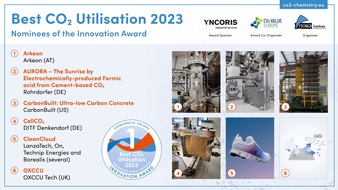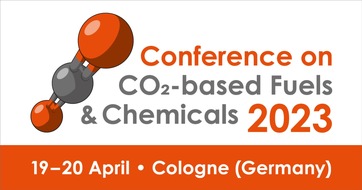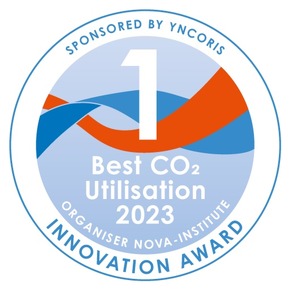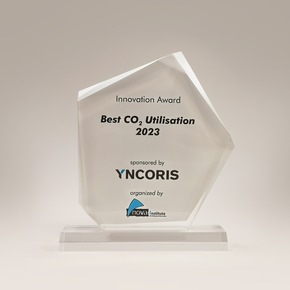From Emission-made Shoes to Jet Fuels – Smart Innovations Make CO₂ the Feedstock of the Future
One document
From Emission-made Shoes to Jet Fuels – Smart Innovations Make CO2 the Feedstock of the Future
The Conference on CO2-based Fuels and Chemicals announces six nominees for the innovation award “Best CO2 Utilisation 2023”.
Smart innovations are helping to rewrite the story of CO2 by providing sustainable carbon sources that can successfully replace fossil carbon.
Last year, the United Nation’s Intergovernmental Panel on Climate Change (IPCC) Assessment Report mentioned for the first time Carbon Capture and Utilisation (CCU) as a solution to decrease net CO2 emissions, as well as a necessary technology to move away from fossil carbon by using CO2 as an alternative feedstock for the production of renewable chemicals and fuels.
This year's nominees for the innovation award “Best CO2 Utilisation 2023” prove that CO2 innovations can be used to design clothes , provide healthy food supplements, produce cleaning and sanitary products, as well as sustainable aviation fuels and building materials. The award is one of the highlights of this year's Conference on CO2-based Fuels and Chemicals (www.co2-chemistry.eu) and celebrates innovative products and technologies in the field of CCU. Every year, the event provides a comprehensive overview of the state of the art of CCU and Power-to-X technologies and applications. An expert jury and the conference Advisory Board selected six promising nominees among 20 interesting submissions received. Those will have the chance to present their CO2 innovation to a broad international expert audience at Maternushaus, Cologne (Germany) and online on 19-20 April 2023.
This year’s selected nominees include a conversion technology for CO2-based amino acids and functional peptides to be used in food products, ultra-low carbon concrete, electrochemically-produced formic acid using cement-based-CO2, a CO2 adsorber material based on amines functionalised cellulosic fibre, a shoe made from carbon-emissions and a process-technology to convert CO2 into jet fuel range hydrocarbons.
Expanding the CO2 Horizon – Six nominees for the innovation award “Best CO2 Utilisation 2023”
Arkeon – Arkeon (AT)
Arkeon’s proprietary technology leverages archaea microorganisms that naturally produce all the building blocks of proteins in only one fermentation. The company’s process converts CO2 directly into amino acids and functional peptides, enabling an entirely new world of food products. With a team that comprises world-leading archaea biologists, process engineers, food scientists and fermentation technologists, the company is on a mission to change food production on a global scale.
AURORA – The Sunrise by Electrochemically-produced Formic acid from Cement-based CO2 – Rohrdorfer (DE)
Formic acid is electrochemically produced from cement-based CO2 by a single step process. The technology provides a cradle-to-gate process from flue gas to a high-value-added chemical. It entails the first CO2 capture plant in a cement company and a one-of-a-kind CO2 electrolyser unit, enabling the single step formation of formic acid, without the further need of purification or acidification. This is achieved by using an adapted PEM water electrolyser setup, modifying only the cathode side, the use of aqueous formic acid as catholyte itself and elevated CO2 pressures. Formic acid is not only a commodity chemical, used in disinfectants, cleaning supplies or rubber production, but also offers options to revolutionise the cement process, enabling net zero cement production, and the protein production.
CarbonBuilt: Ultra-low Carbon Concrete – CarbonBuilt (US)
CarbonBuilt’s revolutionary carbon utilisation technology reduces the embodied carbon of concrete by 70–100%. The technology replaces cement with a proprietary mix of low-cost, low-carbon industrial waste materials. The used CO2 is captured from on-site waste biomass incineration or emerging Direct Air Capture (DAC) technologies to cure (harden) the mix into concrete, storing the CO2 permanently. Because CO2 becomes the key ingredient in ultra-low concrete production (a hundred-billion-dollar market) CarbonBuilt expects to be one of the world’s largest purchasers of captured carbon and thus accelerate development of capture technologies.
CellCO2 – DITF Denkendorf (DE)
The CellCO2 is a CO2 adsorber material based on amines functionalised cellulosic fibre materials e.g., non-woven. The technology starts with the converting of cellulosic fibres into the non-woven followed by chemical modification of the surface with amines. The advantage of using non-woven is the open, air-permeable structure allowing a high air throughput. Furthermore, non-woven also have a large specific surface area, which is advantageous for binding the largest possible volumes of CO2. Due to the structure the material can be used in a continuously operating process that permits continuous and energy-saving operation.
https://www.ditf.de/en/index/research/competence-centers/biopolymer-materials.html
CleanCloud – LanzaTech, On, Technip Energies and Borealis (several)
On is revealing the first ever shoe made from carbon emissions, called Cloudprime. Cloudprime is made from CleanCloud™ ethyl vinyl acetate foam that uses carbon emissions as a raw material. On is the first company in the footwear industry to explore using carbon emissions as a primary raw material for a shoe’s midsole. On is moving away from using fossil feedstock and exploring alternative materials for producing high-performance sports products. CleanCloud™ is the result of a pioneering supply chain partnership with some of the most innovative companies in biochemicals, process and material innovation, including LanzaTech, Borealis and Technip Energies.
http://www.technipenergies.com
OXCCU – OXCCU Tech (UK)
OXCCU is a one-step process that converts CO2 directly into jet fuel range hydrocarbons (and/or alpha olefins for chemicals) by using a novel iron catalyst. The process and catalyst were developed by Prof. Peter Edwards, Dr. Tiancun Xiao and Dr. Benzhen Yao from the University of Oxford (https://www.nature.com/articles/s41467-020-20214-z). OXCCU Tech is commercialising this process. ASPEN modelling has shown that this process has the potential to reduce both Capex and Opex cost by half when compared to a hypothetical two-step Fischer-Tropsch process, thereby significantly reducing the cost of synthetic fuel enabling cost effective scalable sustainable aviation fuel to decarbonise aviation.
The full conference program is available at https://co2-chemistry.eu/program.
nova-Institute would like to thank Yncoris for sponsoring the innovation award “Best CO2 Utilisation 2023” and CO2 Value Europe for co-organising the innovation award. GIG Karasek and Sulzer are supporting the event as Sponsors.
Responsible for the content under German press law (V. i. S. d. P.): Dipl.-Phys. Michael Carus (Managing Director) nova-Institut GmbH, Leyboldstr. 16, DE-50354 Hürth (Germany) Internet: www.nova-institute.eu – all services and studies at www.renewable-carbon.eu Email: contact@nova-institut.de Phone: +49 (0) 22 33-460 14 00
nova-Institute is a private and independent research institute, founded in 1994; nova offers research and consultancy with a focus on the transition of the chemical and material industry to renewable carbon: How to substitute fossil carbon with biomass, direct CO2 utilisation and recycling. We offer our unique understanding to support the transition of your business into a climate neutral future. nova-Institute has more than 40 employees.
Subscribe to our newsletters at http://www.renewable-carbon.eu/newsletters To unsubscribe from this press list, please contact contact@nova-institut.de
Um sich von diesem Presseverteiler abzumelden, kontaktieren Sie bitte contact@nova-institut.de




